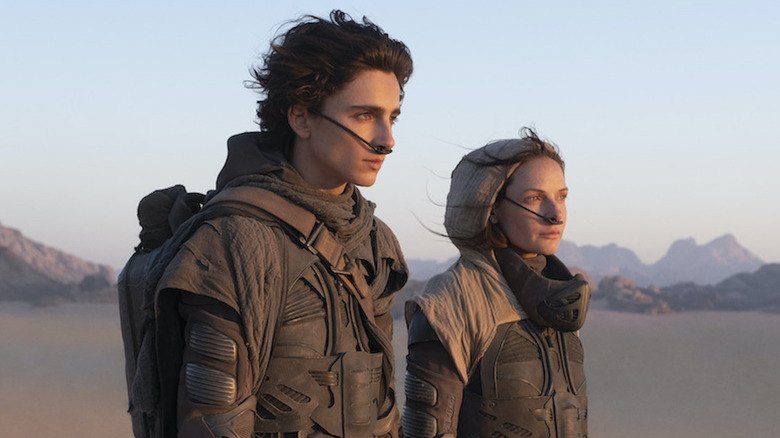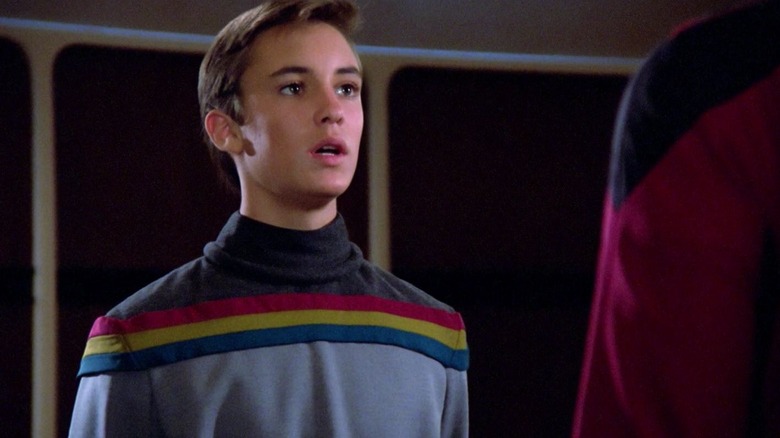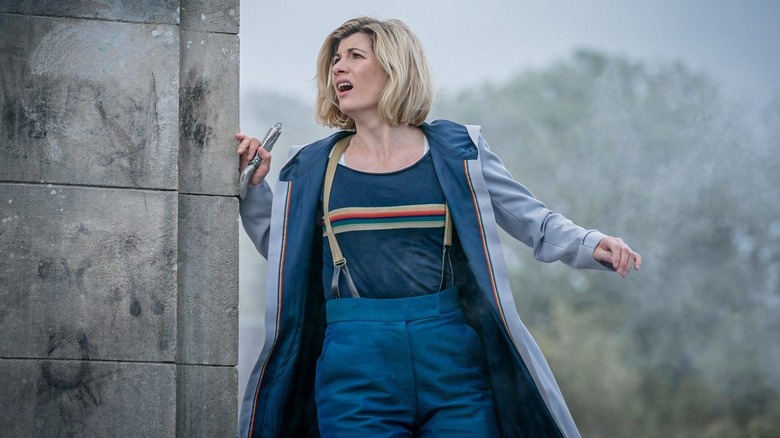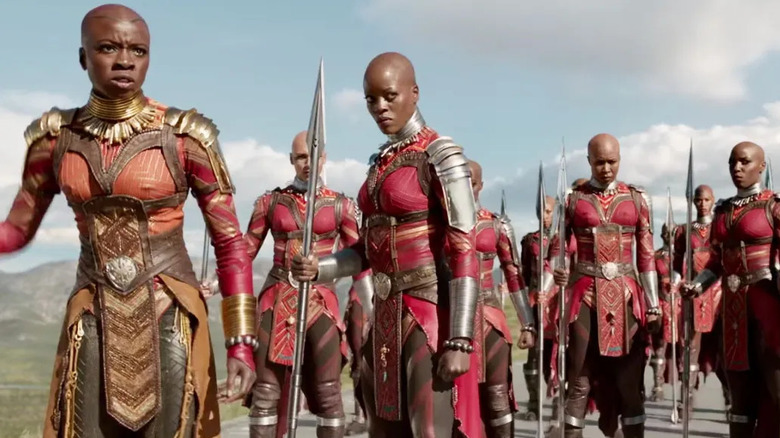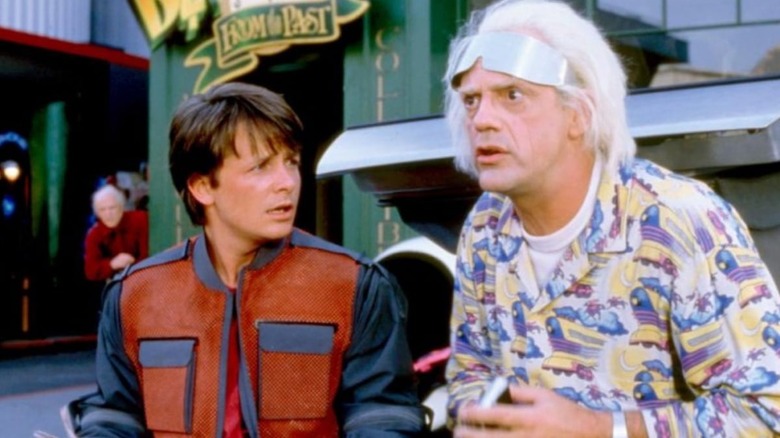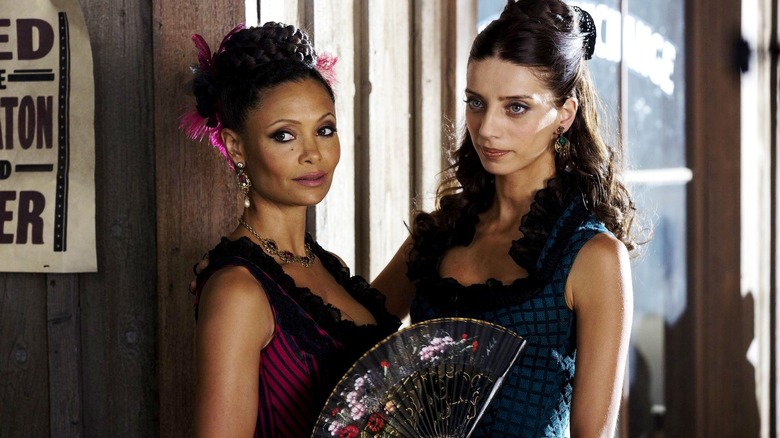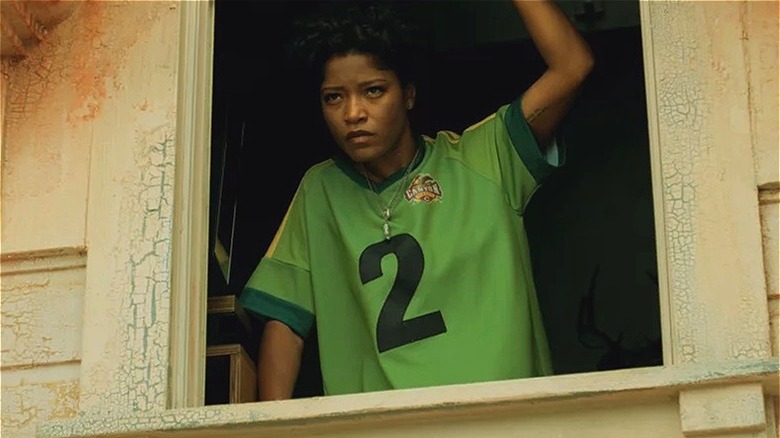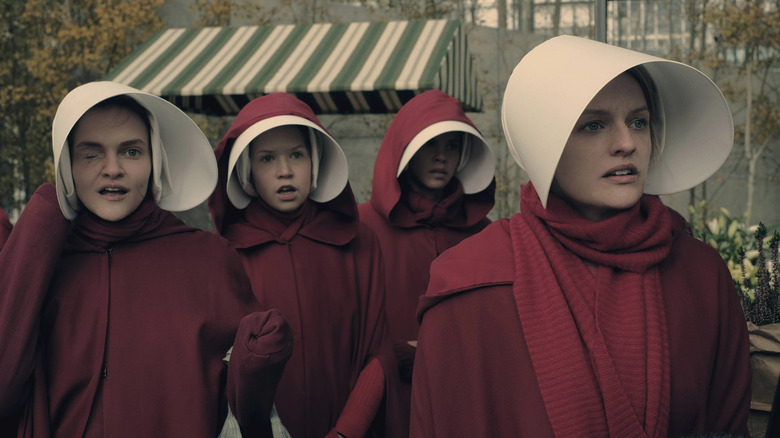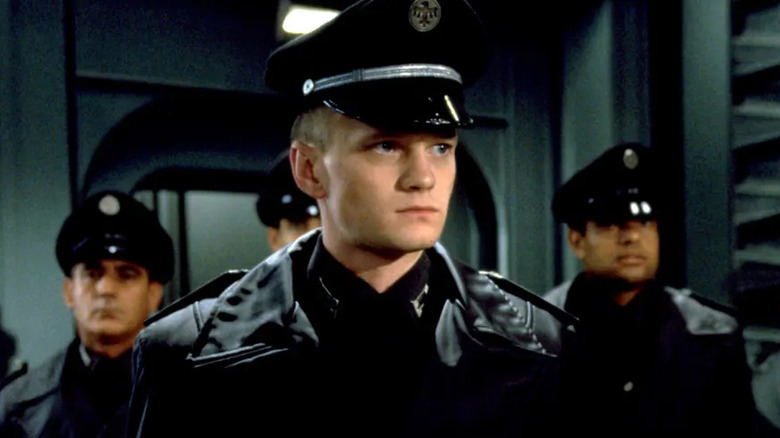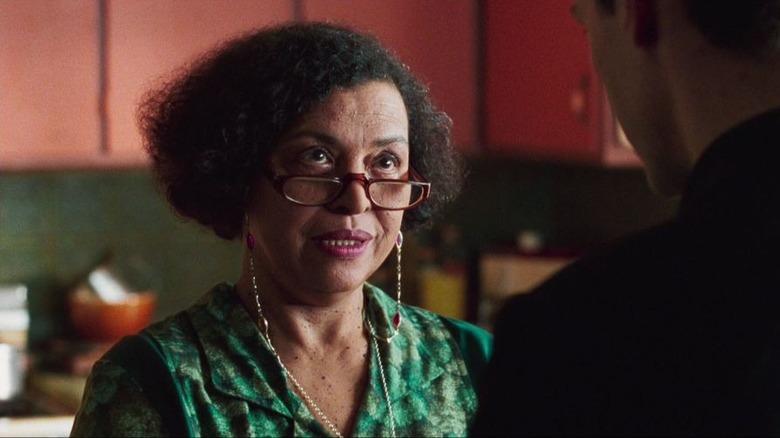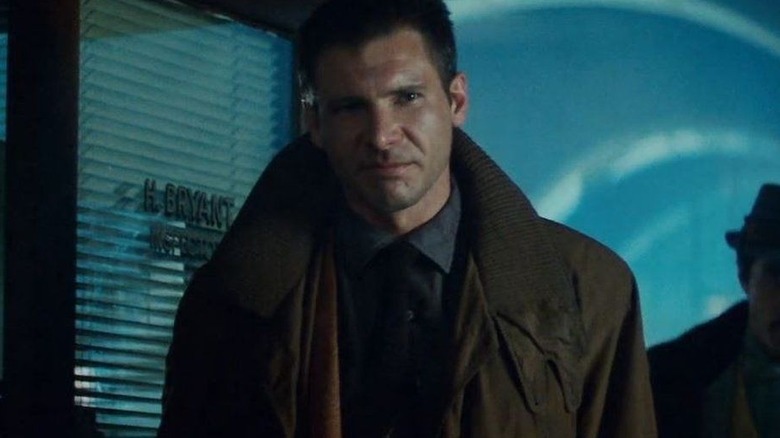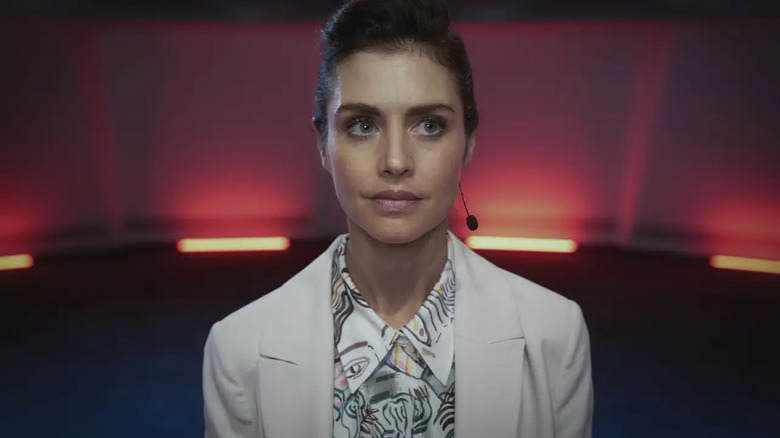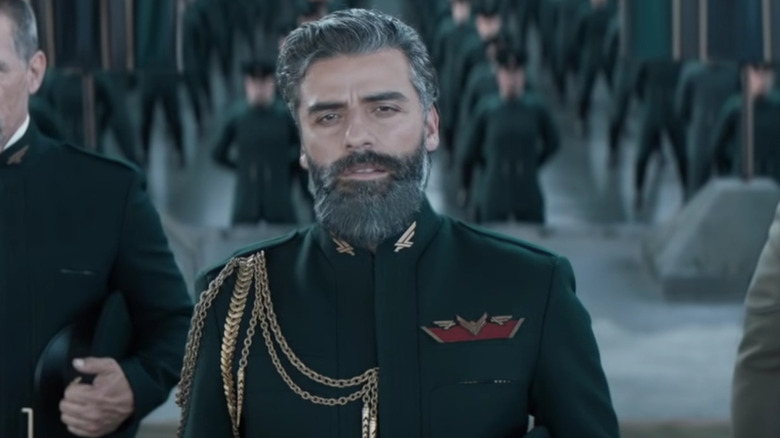Hidden Meanings In Sci-Fi Costumes Explained
Whether traveling through time and space, traversing a dystopian future, or just encountering a strange phenomenon in the backyard, science fiction movies have a unique ability to captivate audiences. The genre uses visuals as more than just spectacle, but as storytelling devices, with larger themes and deeper meaning hidden in the most unlikely places. Thanks to the efforts of countless craftspeople, even the costumes and clothing worn by sci-fi heroes can do more than just cover the actors, sometimes reinforcing the story as well.
While audiences are often enthralled by eye-popping visual effects, it can be easy to miss all the hard work and careful thought put into the design and creation of the costumes in your favorite sci-fi flicks. You may not have noticed how the filmmakers and designers packed each outfit with symbolism, meant to support one of the film's fundamental themes, or provide subtle insight into the characters themselves. It's time to take a closer look at how some of the costumes in your favorite sci-fi classics have more meaning than you ever realized.
The Starfleet Acting Ensign uniform hides a message
Wil Wheaton's Wesley Crusher made his "Star Trek" debut in an episode of "The Next Generation" in 1987. The son of Dr. Beverly Crusher, he's long been one of the fandom's most divisive characters. Some found him to be annoying, some found his super-genius skills preposterous, and others just didn't like the idea of a teenager on the bridge of the Enterprise. Nevertheless, early on in his tenure, Crusher received a provisional rank of Acting Ensign. He's given this honor in the episode "Where No One Has Gone Before" and is provided with his own special uniform, too.
An awkward gray-toned turtleneck with a rainbow stripe that wraps around the shoulders, Acting Ensign Wesley Crusher's unique costume set him apart from the rest of the crew, but it also held a secret message. The colorful stripe across his chest was no mere rainbow for decoration: It's made up of all three divisional colors that are worn by the rest of the crew. Red represents the command division, yellow is for security and operations, and blue is for science and medical. That he has a stripe of all three is to denote that, as a provisional officer, the acting ensign hasn't chosen a division yet. Even to this day, the message is apparently lost on many Trekkies, who never noticed the colorful significance.
The Thirteenth Doctor's outfit has more homages than you might think
Another divisive character with a rainbow pattern across their chest, Jodi Whittaker's Thirteenth Doctor on "Doctor Who" faced sexist backlash following her casting, but few found fault with her colorful, offbeat outfit. Debuting with a blue shirt sporting a rainbow stripe, a long gray coat, and suspenders that hold up a pair of blue trousers, the Thirteenth Doctor had the right mix of style and quirkiness.
But while fans noticed subtle homages to the past — the Fourth Doctor's colorful stripes, the Eleventh Doctor's suspenders, and the high-waisted pants of the Second Doctor — there's more you may have missed. The blue and the gray represent the sky and space, as Whittaker explained in a behind-the-scenes featurette. "And then there's a whole journey of stars and hands," she added, pointing to her carefully selected earrings. "The chain is the journey, and the rose gold hand is humanity."
The actor went on to reveal that costume designer Ray Holman added a violet lining to the sleeves of her coat because it was one of the colors of the Suffragettes, the activists who fought for women's votes in the United Kingdom. For Whittaker, it was important that her costume not be overly feminine or masculine. "The main journey of it came from a photograph that I found of a woman in trousers, braces, and a t-shirt walking with purpose, and I loved it," she said.
The Afrofuturism of Black Panther
A genre-breaking superhero movie that shattered long-held Hollywood perceptions, "Black Panther" saw Chadwick Boseman lead the people of Wakanda to glory. A fictional, hidden African nation, Wakanda is home to a rare element called Vibranium, which allows the country to develop futuristic technology while still honoring the traditions of the ancient peoples who lived on the continent. As revealed by costume designer Ruth E. Carter, many of the futuristic outfits seen in the film pay homage to Africa's past.
Carter, whose previous work includes "Amistad" and "Selma," dug into the past to find influence for the futuristic outfits. Built with a fusion of style called Afrofuturism, Carter ultimately created some 700 unique costumes for the movie, including ceremonial dress and the warrior armor worn by the likes of Okoye. "There's a tabard that runs down the front of their costume that's beaded in the tradition of Africa throughout the continent as especially within the Turkana and the Maasai tribe because I really wanted this to have a feeling that if you were an aspiring Dora Milaje, if you were training and you were granted the position to be a member, that you would be presented with this honor and this beautiful uniform," she told NPR.
For the 2022 sequel, "Wakanda Forever," another 2,000 outfits were produced by Carter, including the Midnight Angel armor worn by Okoye. Using the comic book art as a starting point, real African designs were added. "We landed on a mask style that's very much like the masks of Benin or South Africa, where you see this slanted eye with a round shape," she told Entertainment Weekly.
Doc Brown's shirt hints at a sequel
Among the most important sci-fi trilogies in history, the "Back to the Future" films didn't require much elaborate fictional costuming. The first and third films are set in the past, but 1989's "Back to the Future Part II" plays out in the far off future of 2015, which necessitated newly-created outfits from a fictional future. But, oddly enough, it's not the slick, futuristic fashion worn by Marty McFly, or the cyber-punk costumes of Griff Tannen and his cronies that hide some hidden meaning. Instead, it's the more ordinary attire of scientist Doc Brown.
Throughout the film, Brown dons a wildly colored, loosely fitted button-down shirt. But look closely and you'll see the shirt doesn't feature the Hawaiian flowers you might expect from this kind of outfit, but a repeating pattern depicting a steam locomotive. It's likely no coincidence of course that in the third and final film in the series, Marty and Doc Brown hijack such a train to help bring them back to the future.
In the end, Brown even uses a locomotive as the vehicle for his second time machine, and here it was, a year earlier, being foreshadowed by his costume. But that's not all: Pay close attention to the train hijacking scene in "Back to the Future Part III" and you'll see that Doc uses the same shirt — torn up — as his face covering while playing a gun-toting bandit.
Can you find the color patterns in Westworld?
A mind-bending sci-fi journey through the Wild West — at least at first — "Westworld" is a jaw-dropping mystery peppered with clues for audiences to find. Viewers love to pour over every square inch of every scene looking for evidence to back up their latest theories, hunting for details that may hold some significance. The cast's elaborate costumes are always a good place to start, as they are way more than just randomly chosen outfits meant to look good on screen.
While costume designer Shay Cunliffe insists that many of the decisions for costuming weren't as deliberate as some fans believe, they were indeed influenced by the story's deeper themes. As a result, outfit patterns and fabrics were chosen to reflect the ideas and underlying motifs that made it easy for audiences to make connections. But there was at least one choice that was a deliberate attempt to hide a deeper meaning: The many blue outfits worn in the scene that saw the return of Dolores in Season 3, which was a nod to the iconic blue dress she wore inside the park in the first two years of the show.
Also, when Clementine returned — now in the outside world — her post-modern dress was an intentional matching design to her flowing gown from inside the Westworld park. In an interview with Insider, Cunliffe referred to such callbacks as part of a "theme-song of color" that flowed through the series.
Emerald's retro outfits in Nope were carefully curated
Not all sci-fi movies take place on alien worlds or are set in distant futures. A perfect example of a contemporary sci-fi great is Jordan Peele's "Nope," which sees a brother and sister team encounter a strange phenomenon that may be an organism from outer space. Set at a California ranch, the movie is an alien invasion story that doesn't require its cast to be decked out in the kinds of ornamental sci-fi get-ups you'd see in "Star Wars" or "Star Trek." But that doesn't mean they weren't designed with something bigger in mind.
Speaking to Pop Sugar, costume designer Alex Bovaird revealed how the main cast's seemingly mundane everyday outfits weren't simply thrown together without thought. More than just an odd assemblage of everyday clothing, the outfits were meant to reinforce their personalities, particularly Emerald, played by Keke Palmer. As Bovaird explained, her outfits had to showcase her family's history and include articles from eras past. That meant scouring places like eBay and Etsy for used finds, including old band t-shirts, cowboy boots, and other vintage items.
"She's in charge, and she's fierce, so we wanted to make sure those elements [were reflected in her clothing]," Bovaird said. "All those bands from the late '80s and early '90s are part of mine and Jordan's upbringing, so there's multilayered passion for [the shirts]." She also revealed that the number two on the front of the football jersey worn by Emerald is meant to be nod to the brother-sister relationship at the heart of the movie.
The color-coded costumes in The Handmaid's Tale are inspired by psychology
Based on the seminal novel by Margaret Atwood, "The Handmaid's Tale" takes place in a grim near future where the United States has become an authoritarian nightmare. Women are a subjugated lower class, donning bland robes and bonnet-like head coverings that are color coded based on their role in society: Handmaids wear blood red, the matrons wear royal blue, and so on. The outfits were designed to show the women's loss of power.
"It was kind of twisted to think about how I would hinder women — their body shape, and also their movement and their freedom with the clothing," costume designer Ane Crabtree told Vanity Fair. "I had to do it to make it realistic, but also to help the actors." She went on to explain that she took a "psychological approach" to the color-coded system seen in the show. "There's less and less power as you go down the color spectrum, except with the color red — that is by design from the book."
Everything Crabtree did with the costumes had reasoning behind it. Her job was to create outfits designed by oppressors, though she admitted that she hid a couple of things in the designs that were meant to be a "f*** you" to the men keeping these women down. "I did an inverted female vagina in the design of the Aunt's collars," she said. "If you look subtly, you'll see that."
The Nazi uniforms in Starship Troopers were no accident
The costumes worn by the authoritarian Terran Federation in "Starship Troopers" have visual parallels with those worn by high ranking Nazi soldiers during World War II, and this was no coincidence. Over the years, director Paul Verhoeven has spoken about how the film is a satire of military dictatorships like the Third Reich, and he used costuming to express it. For example, Carl Jenkins (a young Neil Patrick Harris) wears a uniform that starkly invokes the Gestapo, Adolf Hitler's secret police.
Rather than promoting authoritarianism as many critics wrongly believed upon the film's release, the parallels promoted by costuming were meant to be the reverse: A subtle takedown of the frightening way that authoritarian regimes can justify their brutality. "I wanted to do something more than just a movie about giant bugs," Verhoeven told Entertainment Weekly. "What I tried to do is use subversive imagery to make a point about society. I tried to seduce the audience to join [the movie's] society, but then ask, 'What are you really joining up for?"'
Forget everything you know about the Oracle in The Matrix
1999's "The Matrix" may be one of the most analyzed sci-fi films ever made, with fans, critics, and even scholars scrutinizing its deeper symbolism and meaning. From the film's trans allegory to its prescient look at a future ruled by data and consumerism, every detail of the film has been poured over and turned inside out for new truths since its release more than 20 years ago. One element that hasn't escaped the notice of dedicated fans is the costume of arguably the film's most important character, the Oracle.
Depicted as an older, motherly woman, the Oracle can see into Neo's future. She appears in an ordinary suburban kitchen dressed in a green blouse and wearing an orange apron, but eagle-eyed viewers have found that even this simple costume means more than it appears: It seemingly mirrors the work of renaissance master Michelangelo. The outfit recalls the Delphic Sibyl, who appears in a portion of Michelangelo's most celebrated work, the ceiling of the Sistine Chapel. It's hard to argue that this is a coincidence, seeing as the Delphic Sibyl is described as a seer, one of the most powerful prophets in the ancient world. According to legend, she even predicted the Trojan War.
Blade Runner's Deckard is modeled after a famous noir detective
Ridley Scott's "Blade Runner" is an influential cyberpunk sci-fi movie about a government agent who hunts down rogue androids. Everything from the dialogue and the sets to the use of color and lighting is meant to pay homage to old detective movies, and the same can be said of the costumes on display: Rick Deckard's carefully chosen look is actually influenced by movies of that era.
"After reading the script, we definitely felt that 'Blade Runner' was of that film noir genre, and we looked back to the films of the 1940s for inspiration," said costume designer Michael Kaplan in a chat with AnOther magazine. Kaplan went on to say that "Deckard was as much a Gumshoe as Sam Spade," referencing the 1941 classic "The Maltese Falcon," and it's easy to spot the similarities. With the era-specific dusted overcoat and button-down shirt, Deckard's costume is an obvious tip of the cap to the iconic detective, a sort of futuristic Spade.
The sequel, 2017's "Blade Runner 2049," went down a different route. It's set 30 years later and the world is an even worse place, so the costumes had to reflect that. The clothing in the belated follow-up film is tougher, more durable, bulkier, and even uglier, admits designer Renée April. "I didn't want costumes with [lots of] zippers and plastic," she told IndieWire. "So my job was to make the characters believable."
Rebecca's outfits in The One demonstrate her growth
The Netflix original series "The One" is set in a near-future where genetics rule and a match-making app for singles finds everyone's perfect partner. Over the course of the story, the characters grow and change in a myriad of ways, and the costuming plays a big role in hammering those changes home. This is most evident in Rebecca, founder of dating service MatchDNA. We see her in flashbacks starting her career as a researcher before eventually becoming a powerful executive.
In an interview with The Indiependent, costume designer Jo Slater admitted that she initially struggled with Rebecca's pre-fame and fortune look. "We went for a more boho route because we knew we were going to end up in power suits," she said. "There was a kind of freedom to her costumes when we first meet [Rebecca], comfortable in her own skin and we wanted to show that. Then we moved to the buttoned-up, anxious, present-day look." With such attention to detail, "The One" is further proof that costumes can be just as meaningful to a story as dialogue or plot in the world of science fiction.
Dune's outfits are inspired by brutalism
Set in a distant galaxy, 2021's "Dune" is a sweeping outer space saga where rival houses battle for control of a vast interstellar empire. It features a number of brilliantly designed and carefully crafted sci-fi costumes. The story calls not just for futuristic battle suits and outfits suitable for the environments on harsh alien worlds, but also formal attire for the powerful House Atreides.
The architecture of the film is drawn from a school of design called brutalism, and some of the outfits on display have a similar origin. In 2021, The Hollywood Reporter spoke to costume designer Jacqueline West about where she got her inspiration. "You want it simple, stripped-down, utilitarian. I approached nearly all of the costumes that way," she said. "I never wanted anything to look over-reaching, or overdone and baroque in any way."
West took cues from the Romanov family, the last dynasty to rule Russia before the revolution. "I thought their costumes were quite elegant yet simple," she explained. Why the Romanovs, though? It's quite simple: Photos of the Romanovs show a "doomed family, just like the House of Atreides," West said. "Everything was about to be taken away from them. I thought there would be some symbolism for the audience to see and feel that. Maybe they would make that connection, even subliminally."
